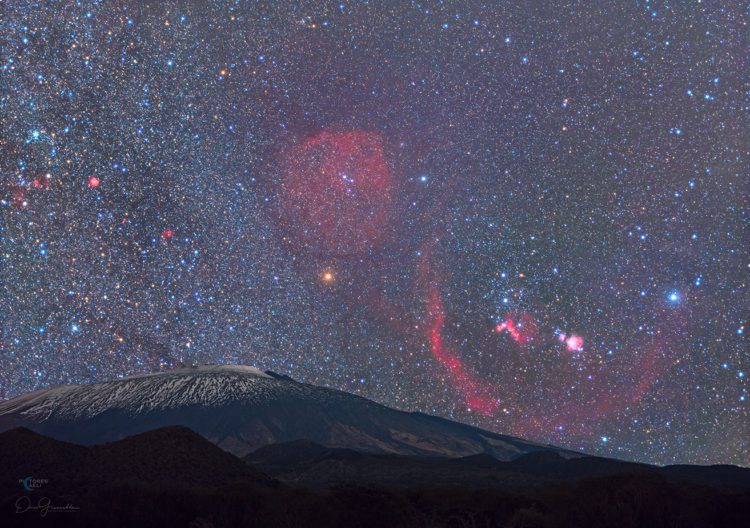Orion Rises Over Mount Etna
Description
Constellation Orion in all its beauty as it rises above the flank of the Etna Volcano. The choice of the shooting point has been carefully evaluated in order to contain the entire constellation above the newly snow-capped volcano using a 50mm focal length, an astro-modified camera to reveal the nebulae, and photo-composite technique to include multiple exposures.
Orion is certainly the most beautiful constellation in the winter sky. It is located in a region of sky full of bright stars such as Sirius in the southeast, Procyon in the east, Castor and Pollux in the northeast, Capella in the north and Aldebarana in the northwest. The brightest star is Rigel, the beta, of magn. 0.1, which is 773 light years away. If it appears so bright, despite the distance, it means that it is a true cosmic lighthouse capable of shining 44,000 times more than the Sun.
The star Alpha, Betelgeuse, is a super giant so large that it can contain the orbit of the earth if it were al place of the Sun. Its brightness varies from 0.2 to 0.8 although generally it is 0.5. Another (slightly) variable star among the main ones is Mintaka (Delta, 2.2m) located almost at the celestial equator. The Theta star, in the center of the large M42 nebula, is known as the trapezoid, from the position of the four main components. It is the very hot stars of the trapezoid that excite the gases of the nebula and make it shine. Much more elusive is the horsehead nebula or Barnard 33 which forms a dark bay on the IC434 nebula.
The constellation also appears enveloped by a large ring nebula that takes the name of Barnard’s Ring. On the shoulders and around the star Meissa, there is a large diffuse nebula named SH 2-264. Particularly curious is the shape of the witch’s head nebula or NGC1909, a reflection nebula, which is located in the constellation of Eridanus but in front of Rigel who is precisely the source of light. There are several versions around the myth of Orion. The most famous one tells that Orion, a giant hunter, boasted to the goddess Artemis, and her mother, that he was the most skilled hunter and that he could kill any beast on earth. Then Gea (the earth), indignant for his presumption, shuddered and from a crack in the ground he made a scorpion come out that stung him making him die. Since then the hunter and the uncovering are deadly enemies to the point of being placed in opposite points of the sky so as to never meet.
Technical info: a blend of multiple exposures using the Same lens from the same position. Canon 6d astro-modified, Sigma 50mm, f/2, 2 min, iso 400. Sky: 19 light frames, 17 dark frames, 17 flat frames, 17 flat dark frames, tracked by Vixen Polarie
Landscape: one single frame, same parameters

comments (0)